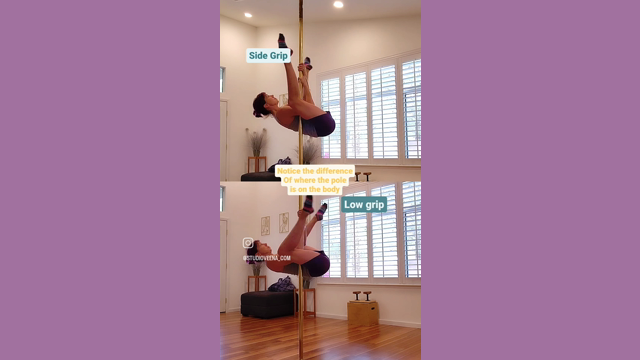CHOPPER INVERT How to get your butt up

Let’s talk about the deadlift (no momentum) Chopper/Invert and why you might have such a tough time getting yer butt up!
I see people struggle the most when using what I call a Low Grip, I consider Low Grip to be an advanced hold and not the first grip to learn for Inverts. In my tutorials, I have you start with the Side Pole Hold (shown in video).
Let’s break down the different grips.
LOW GRIP
1. It requires more strength because the biceps and back have to do all of the heavy lifting, fighting to keep your arms from extending too soon, which drops the hips. You’re also having to hold your whole body up, which let’s face it, our bodies are not light!
2. It can make lifting the chest to help engage the shoulders and back challenging. Often resulting in shoulders lifted to the ears and rounded backs.
3. It places the body and hips lower on the pole, changing the center of gravity/pivot point. Because of this, if you have long limbs or you’re tall, you’ll need even more strength for this grip. Shorter folks will sometimes be able to use the hip as a pivot point, which is helpful.
4. Because Low Grip requires more strength from the biceps and back, most who are new to Inverts tend to flop or drop down when exiting, because they have to extend the arms too soon. This can cause injury and doesn’t develop a good habit for Inverts.
SIDE GRIP (SIDE POLE HOLD)
1. Requires less strength because you’re actively squeezing the pole between the bicep and torso, removing some of the stress off of the biceps and back.
2. Allows for easier, more natural positioning, encouraging correct shoulder and back engagement. Chest up buttercup!
3. The side grip allows for a safer “no flop” dismount because most people can get the hips up high enough to hook the leg. So, instead of flopping down, you can slide down safely, reducing stress on the body.
4. Also, the Side Pole Hold can be used with controlled momentum, which can make Inverts even easier and less strenuous on the body. If you’d like to learn more grips, leg positions, and general tips for inverts check out my Ultimate guide to inverts!


Responses